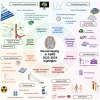Recent advances in neuroimaging of Alzheimer's disease and related dementias
- PMID: 40922096
- PMCID: PMC12417339
- DOI: 10.1002/alz.70648
Recent advances in neuroimaging of Alzheimer's disease and related dementias
Abstract
This review covers recent advances (2023-2024) in neuroimaging research into the pathophysiology, progression, and treatment of Alzheimer's disease (AD) and related dementias (ADRD). Despite the rapid emergence of blood-based biomarkers, neuroimaging continues to be a vital area of research in ADRD. Here, we discuss neuroimaging as a powerful tool to topographically visualize and quantify amyloid, tau, neurodegeneration, inflammation, and vascular disease in the brain. We examine the utility of neuroimaging for (1) tracking the spatiotemporal progression of pathology, (2) serving as the reference standard for validating novel fluid biomarkers, (3) characterizing disease heterogeneity, (4) exploring the role of brain networks in ADRD progression, and (5) evaluating biomarkers for better individualized estimates of treatment benefit. Finally, we discuss advances in radiotracer development and AD risk factors. By reviewing the most promising breakthroughs in the neuroimaging field, we hope to spark new ideas for future discoveries that will deepen our understanding of ADRD. HIGHLIGHTS: The diagnostic and staging criteria for Alzheimer's disease (AD) were updated in 2024. Despite robust harmonization methods for amyloid beta positron emission tomography (PET), parallel efforts for tau PET remain challenging. Larger anti-amyloid drug effects were seen at lower levels of amyloid and tau PET. Phosphorylated tau217 (p-tau217) is currently the most promising plasma biomarker to detect AD pathology. There are new tracer developments for alpha-synuclein, primary tauopathies, and inflammation.
Keywords: Alzheimer's disease; amyloid; cerebrospinal fluid biomarker; cerebrovascular disease; clinical trials; connectivity; co‐pathology; disease staging and subtyping; heterogeneity; inflammation; neuroimaging; plasma biomarker; positron emission tomography; risk factors; tau.
© 2025 The Author(s). Alzheimer's & Dementia published by Wiley Periodicals LLC on behalf of Alzheimer's Association.
Conflict of interest statement
R.L.J. consulted for GE Healthcare. G.S. has received speaker fees from Springer and Adium. J.O., N.O., M.B., A.P.B., M.S.K., D.M.C., M.E., L.E.M.W., M.G., and T.B. have nothing to disclose. Author disclosures are available in the supporting information.
Figures



References
Publication types
MeSH terms
Substances
Grants and funding
- CIHR-PJT-190220/Canadian Institutes for Health Research
- CIHR-187890/Canadian Institutes for Health Research
- ALZ23-05/Alzheimer Society of Canada
- ALZ26-021/Alzheimer Society of Canada
- 24AARF-1242638/ALZ/Alzheimer's Association/United States
- 22AARF-972612/ALZ/Alzheimer's Association/United States
- SG-666374-UK/ALZ/Alzheimer's Association/United States
- AARG-22-926899/ALZ/Alzheimer's Association/United States
- AS-DRL-23-005/Alzheimer's Society Dementia Research Leaders Fellowship
- National Institute for Health and Care Research University College London Hospitals Biomedical Research Centre
- 101061836/European Union's Horizon 2020 Research and Innovation Program
- Strategic Research Area MultiPark
- A2024012F/BrightFocus Foundation
- A2024007F/BrightFocus Foundation
- R01AG080766/National Institutes of Health National Institute on Aging
- P30AG062715/National Institutes of Health National Institute on Aging
- R01AG027161/National Institutes of Health National Institute on Aging
- P30AG062422/National Institutes of Health National Institute on Aging
- 24AARF-1242638/Brain Canada
- AF-980942/Alzheimerfonden
- AF-994514/Alzheimerfonden
- AF-1012218/Alzheimerfonden
- BMBF/ERAPerMed
- 01KU2203/ERAPerMed
- Alzheimer's Society Research Program
LinkOut - more resources
Full Text Sources
Medical

